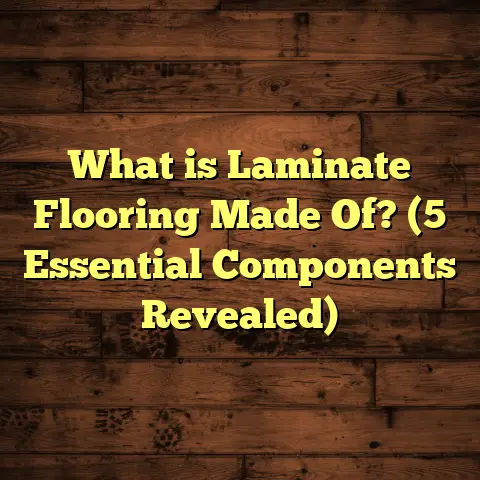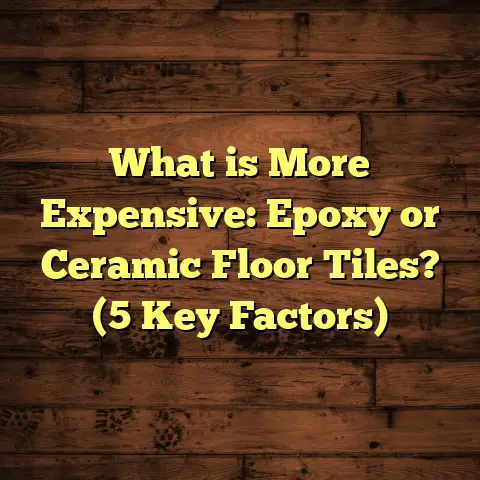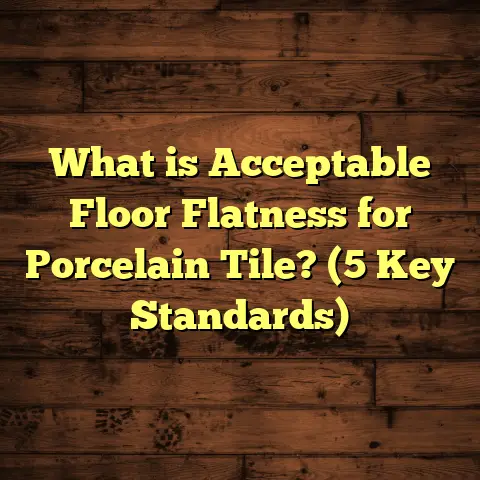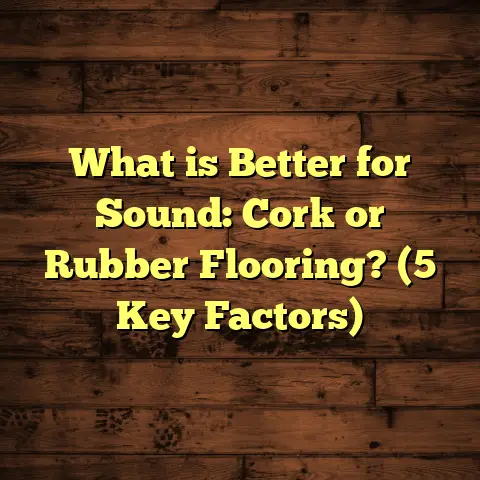What is Cheap Flooring? (5 Budget-Friendly Options Revealed)
Innovation has completely changed how we think about home flooring over the years. When I first started working in this field, floors were mostly seen as a practical necessity—something to cover the ground and protect your feet. But now, thanks to new materials, smarter manufacturing, and improved installation techniques, flooring can be a key design feature in any space.
I’ve been lucky to witness these changes firsthand, working on countless projects that range from quick budget refreshes to major remodels. One thing always comes up early in conversations with clients: “I want something affordable but nice-looking—what’s out there?” That’s where the idea of cheap flooring comes into play. But what does “cheap” really mean? Is it just about price, or should you be looking deeper?
What is Cheap Flooring?
When I say cheap flooring, I’m not just talking about the lowest possible price tag. To me, cheap flooring means flooring options that balance affordability with decent quality, durability, and aesthetics. It’s about getting the best bang for your buck without settling for something that will fall apart in a year or look like a bargain bin item.
In my experience, cheap flooring doesn’t have to mean low quality. Many budget-friendly materials have evolved so much that they can stand toe-to-toe with pricier options in terms of durability and style. For example, vinyl planks today can mimic hardwood so well that most people can’t tell the difference without getting close.
Cheap flooring is often chosen by people who are renovating on a budget, renting out properties, or simply want to refresh a space without spending a fortune. It’s also popular for rental homes where long-term durability isn’t the biggest concern but cost-effectiveness is.
So, cheap flooring is really about smart choices—picking materials and installation methods that fit your budget while still meeting your needs for function and style.
My Flooring Journey: Lessons Learned About Budget-Friendly Floors
I remember one project that really shaped my view on affordable flooring. A friend was renovating her first house and had a tight budget for floors throughout her living room, kitchen, and bathroom. We explored several options—hardwood was way out of reach due to cost and installation complexity.
After weighing pros and cons, we settled on vinyl plank flooring. It was affordable (around $3 per sq. ft.), looked great, was water-resistant, and easy to install. Watching that floor hold up beautifully for several years reinforced my belief that cheap doesn’t mean disposable.
Since then, I’ve worked with hundreds of clients using vinyl plank, laminate, ceramic tile, carpet tiles, and engineered wood—all affordable options with different strengths.
5 Budget-Friendly Flooring Options Revealed
Let’s talk specifics. Here are five popular flooring types I regularly recommend when cost is a major factor. I’ll share their pros and cons based on my work with them.
1. Vinyl Plank Flooring: Affordable Durability and Style
Vinyl plank has become a staple in budget flooring projects I take on. It’s essentially plastic planks designed to look like wood or stone with a textured surface to mimic natural grain or texture.
Why I like it:
- Cost: Material costs usually range from $2 to $4 per square foot—very reasonable compared to real hardwood which can be $8+ per sq. ft.
- Waterproof: Great for kitchens, bathrooms, basements—areas where moisture is an issue for wood or laminate.
- Installation: Many vinyl planks come with click-lock systems making DIY installation easier than ever.
- Durability: Resistant to scratches, stains, and dents if you pick quality brands.
I had a client with three kids and two dogs who chose vinyl plank for their open-plan living area. After four years and plenty of spills and pet traffic, the floor still looked fresh with minimal care.
Stats: According to a 2023 market study by Freedonia Group, vinyl plank sales in North America have grown by 17% annually over the past five years due to its affordability and ease of installation.
Considerations: Some cheaper vinyl flooring can feel hollow or plasticky underfoot, so it pays to invest a bit more for thicker wear layers.
2. Laminate Flooring: Wood Look Without the Price Tag
Laminate flooring is another budget-friendly favorite of mine. It features a photographic layer that replicates wood or stone patterns topped with a durable clear coating.
Why it works:
- Price: Material costs typically fall between $1 and $3 per sq. ft., making it one of the least expensive solid-surface options.
- Appearance: High-quality laminates are surprisingly realistic, often hard to distinguish from real wood at a glance.
- Installation: Like vinyl plank, many laminate floors use click-lock systems suitable for DIY installs.
From personal experience installing laminate in my own guest bedroom years ago, I found it holds up well in low-moisture areas with moderate wear.
Drawbacks: Laminate is vulnerable to water damage when moisture seeps in between seams. So it’s not ideal for bathrooms or basements unless you choose specially treated waterproof versions.
Data: A recent survey by HomeAdvisor found laminate floors last on average 10-15 years with proper care—comparable to some mid-range wood floors.
3. Ceramic Tile: Timeless Durability at Budget Prices
People often think tile is expensive because they picture fancy natural stone or high-end porcelain. But ceramic tile comes in numerous styles and price points—including very affordable options starting under $1 per square foot.
Why tile makes sense:
- Durability: Ceramic is hard-wearing and resistant to moisture, stains, and scratches—perfect for kitchens and bathrooms.
- Variety: Comes in countless colors, patterns, and finishes allowing customization without high costs.
- Maintenance: Easy to clean and maintain over time.
For one kitchen remodel I managed, we combined budget ceramic tiles with decorative accent strips to keep costs low while delivering an attractive finish.
Installation note: While materials can be cheap, professional installation can add significantly to cost due to labor-intensive processes like grout application and cutting tiles.
Case study: A client finished their bathroom renovation on a $5,000 budget by choosing mid-range ceramic tile instead of pricier natural stone—saving about 30% without sacrificing durability or style.
4. Carpet Tiles: Practical Comfort With Easy Replacement
Carpet tiles don’t get as much attention as other types but can be a surprisingly affordable solution for certain rooms like basements, offices, or playrooms.
Why they’re useful:
- Cost: Usually range between $1.50 and $3 per square foot—similar to laminate but offering softness underfoot.
- Modularity: If one tile gets stained or damaged, you replace just that section rather than the whole floor.
- Installation: Most come as peel-and-stick or glue-down products suitable for DIY projects.
For a client’s basement rec room used heavily by kids and pets, carpet tiles provided comfort and were easy to swap out after wear without major disruption.
Maintenance: They require regular vacuuming but are easier to spot clean than wall-to-wall carpet.
5. Engineered Wood Flooring: Real Wood Look at Mid-Range Price
Engineered wood offers real hardwood on top but uses layers of plywood underneath for better stability and lower cost than solid hardwood planks.
Why I recommend engineered wood:
- Appearance: You get authentic wood grain and warmth that laminate or vinyl can’t fully replicate.
- Price: Generally runs $4 to $7 per sq. ft., cheaper than solid hardwood which can be $8-$12+ per sq. ft.
- Durability: More resistant to temperature fluctuations and moisture than solid wood—good for basements or above radiant heat systems.
I’ve installed engineered wood in homes where clients wanted genuine wood aesthetics but couldn’t afford solid hardwood throughout their entire house.
Research insight: A 2023 consumer report showed engineered wood retains about 85% of its resale value compared to 95% for solid hardwood—making it an excellent mid-range investment option.
How I Use FloorTally for Cost Estimation
Estimating costs accurately is one of the trickiest parts of any flooring project I’ve tackled. Early on, I used spreadsheets and called multiple suppliers for quotes—it was time-consuming and often led to surprises during installation when waste or labor costs weren’t factored properly.
FloorTally has become my go-to tool lately because it streamlines all those calculations into one place. When I’m planning a project now, I plug in room dimensions, select materials from their extensive library (which considers local market prices), and get detailed estimates including labor rates specific to my area.
One recent project involved replacing old carpet with laminate across about 1,200 square feet. Using FloorTally helped me estimate materials plus labor within minutes instead of days of back-and-forth calls. It also calculates waste allowances so I order just enough extra material without overbuying.
This saves me money and gives my clients clear expectations on budget upfront.
How Do These Budget Floors Compare?
Let’s put these five options side-by-side based on key factors:
| Flooring Type | Average Cost (Material + Installation) | Durability | Water Resistance | DIY Friendly | Style & Appearance |
|---|---|---|---|---|---|
| Vinyl Plank | $5–$8 per sq.ft | High | Excellent | Very | Wood/stone looks |
| Laminate | $3–$7 per sq.ft | Moderate | Low (unless waterproof) | Yes | Wood-look |
| Ceramic Tile | $6–$12 per sq.ft | Very high | Excellent | Moderate (skill needed) | Wide variety |
| Carpet Tiles | $3–$6 per sq.ft | Moderate | Low | Very | Variety of textures/colors |
| Engineered Wood | $7–$10 per sq.ft | High | Moderate | Moderate | Real wood appearance |
Which One Should You Pick?
The right choice depends on your home’s needs:
- Wet areas (bathrooms/kitchens): Vinyl plank or ceramic tile work best due to water resistance.
- Living rooms/bedrooms: Engineered wood or laminate provide warm looks.
- Basements/rec rooms: Carpet tiles or vinyl plank offer comfort and durability.
- Rental properties: Vinyl plank or carpet tiles provide easy maintenance at low cost.
- DIY projects: Vinyl plank and laminate are the easiest for non-professionals.
Some Personal Stories from the Field
One time, I helped a young couple renovate their rental property on a shoestring budget of $2,000 for all floors across three rooms. We went with peel-and-stick carpet tiles for bedrooms and vinyl plank in living spaces.
They were thrilled with how modern the home looked after installation—and when one tile got stained by a pet accident months later, replacing it was painless. This small detail made a big difference compared to dealing with wall-to-wall carpet replacements.
Another client wanted hardwood but couldn’t afford it across their entire home budget-wise. We installed engineered wood in main areas and vinyl planks in less-used rooms—a combo that balanced luxury feel with budget constraints beautifully.
Final Thoughts
Choosing cheap flooring isn’t about sacrificing quality—it’s about making smart decisions based on your needs and budget. Over the years working hands-on with all these materials, I’ve learned that affordable floors can be durable, stylish, and easy to maintain when chosen wisely.
Innovation keeps pushing these options further—vinyl planks now look more realistic than ever; laminate has waterproof versions; engineered woods combine beauty with stability; tiles come in endless affordable designs; carpet tiles offer flexibility unheard of before.
If you’re planning a project on a budget but want something that lasts longer than just a few months or looks better than bargain-bin floors, vinyl plank, laminate, ceramic tile, carpet tiles, or engineered wood are all worth considering depending on your space.
Got any flooring questions or want advice tailored to your home? I’m here to share what I’ve learned from years of installing floors one room at a time.





